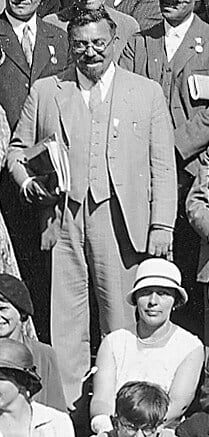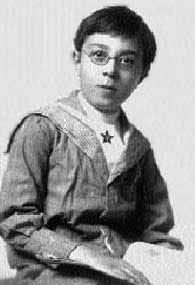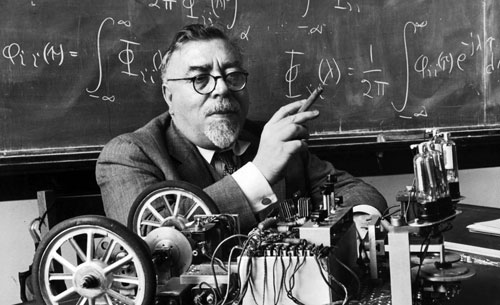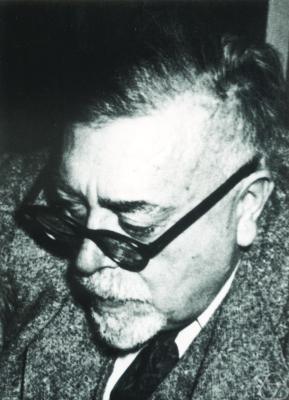
©Johannes Meiner, Public domain, via Wikimedia Commons – Original / License
Who was Norbert Wiener?
Norbert Wiener was a famous American mathematician who took the field of math and expanded it to a variety of other areas, ultimately culminating in the development of Cybernetics, an all-encompassing field that dealt with the interaction of feedback loops and behavior.
Early Life
Norbert Wiener was born on November 26, 1894, in Columbia, Missouri. His father, Leo, earned a living teaching Slavic and German languages to others. He was also related to a line of famous Jewish rabbis, and this unquestionably influenced Wiener’s religious upbringing.
Quick Facts
- Full Name
- Norbert Wiener
- Birth
- November 26, 1894
- Death
- March 18, 1964
- Net Worth
- N/A
- Awards
- Bocher Memorial Prize
- National Medal of Science
- Children
- Peggy, Barbara
- Nationality
- American
- Place of Birth
- Columbia, Missouri
- Fields of Expertise
- [“Mathematics”]
- Institutions
- Tufts College, Cornell University, Harvard University, MIT
- Contributions
- Father of Cybernetics, Wiener’s Law, Wiener Equation, Wiener Filter
Wiener was taught at home until he was 7 and showed an immediate gift for mathematics. It was quickly apparent that he was a child prodigy, and he graduated from high school at the tender age of 11. He attended Tufts College shortly thereafter and graduated from the school with a BA in Mathematics in 1909 at the age of 14. At 17, he graduated from Cornell with a graduate degree in Philosophy. Next was Wiener’s Ph. D., which he earned from Harvard at the age of 19 after successfully defending his dissertation.

His dissertation then postulated that ordered pairs can be understood via set theory.
Until the outbreak of World War I in 1917, Wiener worked many jobs, including teaching philosophy, serving as an Engineer for General Electric, and working as a reporter for the Boston Herald.
Career
Professor at MIT
Wiener struggled to get a job elsewhere, something he chalked up to anti-Semitism that was so prevalent in educational society during the time period. He was ultimately hired by MIT as a professor of mathematics.
Guggenheim Scholar in Europe
Wiener moved back to Europe in 1926 after his selection as a Guggenheim Scholar, meaning that he was given a financial grant by the John Simon Guggenheim Foundation to move to Europe and continue his studies. It was here that Wiener made many of his most significant contributions to the world of math, including his work on Brownian Motion.
Contributions to the War Effort
During World War II, Wiener worked with the Allied forces to apply his mathematical skills to improve weaponry. This ultimately led to the invention of the Wiener Filter and Cybernetics.
Post-War Career
After the War, Wiener would return to MIT, where he would recruit other individuals to work on a variety of processes, including artificial intelligence and cognitive science. It was here that Wiener would develop a relationship with a core group of scientists that included John von Neumann and enhanced his work on automation.
What Did Norbert Wiener Do and Invent?
Cybernetics
Cybernetics was first envisioned by Wiener and is an amalgamation of numerous fields, including mathematics, phycology, engineering, and more. Wiener described the entire field as one that dealt with “control and communication” between animals/humans and machines in general. It studied feedback and the impact that feedback would have on the behavior of animals and humans alike. This ultimately resulted in feedback systems.
Communication theory was also a large part of cybernetics. Under this communication theory, the way that animals and machines communicated with each other were considered critical to the feedback that the animal and machine ultimately received and how they behaved. In this regard, Wiener’s communication theory was a core component of his belief in cybernetics.
Another critical component of Cybernetics was automation. Wiener noted that there were striking similarities between automation when it came to human and machine behavior. As such, Wiener believed that Cybernetics could have an impact in the area of automation, but specifically in terms of how many facets of human behavior were automated.
General Philosophy
Wiener described himself as a pacifist, yet he attempted to enlist in World War 1, ultimately failing to meet the necessary physical requirements. However, his scientific work proved useful to the Allies in the war effort, thus belying his pacifism.
After the war, Wiener became more concerned about political and military interference, turning down money from both of these sources as part of his ongoing scientific research. He became more active in this area, urging fellow scientists to consider the ethical and moral implications of their work.
Brownian Motion & Wiener Process
Brownian Motion is the idea that any physical property is constantly undergoing some small, random physical movement and changes. Unless there is intentional movement or outside forces influencing the medium, the medium itself will gradually spread over a surface, diffusing across the medium. Brownian Motion was later expanded upon by the Wiener Process, developed by Norbert Wiener. Wiener expanded upon the idea behind Brownian Motion in a series of formulas that helped to mathematically explain this diffusion process.
Wiener Equation
The Wiener Equation is the mathematical representation of Brownian Motion and the Wiener Process. It helps to mathematically explain just how Brownian Motion works.
Wiener Filter
The Wiener Filter helps to explain how a randomized process – such as noise – can be turned into the desired process. It helps to limit random noise and remove other feedback.
Norbert Wiener: Marriage, Divorce, Children & Personal Life
Marriage
At the age of 32, Wiener’s parents arranged a marriage between him and Margaret Engemann, who was a professor at nearby Juniata College. They remained married until Wiener’s death.
Children
Wiener and Margaret had two daughters, named Barbara and Peggy.
Death
Wiener died suddenly in 1964 at the age of 69. The cause of death was listed as a heart attack.
Norbert Wiener: Awards and Achievements
Bocher Memorial Prize
The Bocher Memorial Prize is awarded by the American Mathematical Society for a research memoir or piece of analysis that appeared within the past six years. In 1933, Wiener won the prize with Marston Norse for their work on the foundations of a calculus theory. They were only the fourth to ever be awarded this prize.
National Medal of Science
The National Medal of Science is an award of the National Science Foundation that is given to individuals who have made contributions to certain fields, including mathematics. This award was actually established by the United States Congress in 1959. Wiener won this award in 1963.

Norbert Wiener: Published Works and Books
In total, there are at least 43 books published under Wiener’s name and many of Wiener’s most famous quotes originate from these books. These works include:
Norbert Wiener: A Life in Cybernetics (autobiography)
This is Wiener’s autobiography. In this autobiography, Wiener discusses his life story and the various areas of science that influenced his life. He also specifically discusses the formulation of Cybernetics and the theory of feedback systems.
The Human Use of Human Beings: Cybernetics and Society
This text – written in 1950 – advances the benefits of cybernetics. However, it also goes one step further: In the book, Wiener argues for the benefits of automation and a more automated society, noting that automation can enhance the ways in which humans cooperate with each other. He also discusses ways in which machines and machinery can improve the life of humans while examining the potential risks of this automation and determining ways to limit its negative impact.
Cybernetics Or Control And Communication In The Animal And The Machine
This book is another seminal work in the field of Cybernetics. In it, Wiener expands upon the philosophical justification behind Cybernetics and gives an overview of the technical and philosophical underpinnings beneath the field.
God & Golem
This book is a continued exploration of the field of Cybernetics, albeit from an entirely different perspective: It examines the various religious applications of cybernetics, automation, and machine learning.
Norbert Wiener Quotes
“The world of the future will be an even more demanding struggle against the limitations of our intelligence, not a comfortable hammock in which we can lie down to be waited upon by our robot slaves.”
“We are not the stuff that abides, but patterns that perpetuate themselves.”
“Progress imposes not only new possibilities for the future but new restrictions.”
The image featured at the top of this post is ©Konrad Jacobs, CC BY-SA 2.0 DE, via Wikimedia Commons – License / Original


